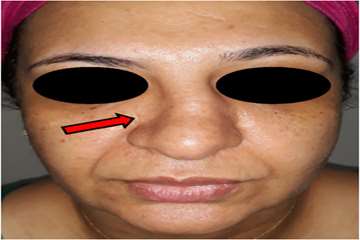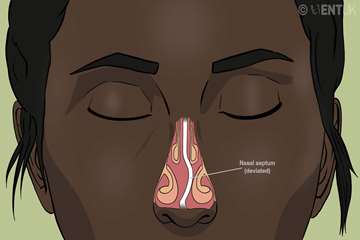(Septoplasty)
Comprehensive Article on Deviated Septum Surgery

Comprehensive Article on Deviated Septum Surgery (Septoplasty)
Introduction
Deviated septum surgery, or septoplasty, is one of the most common surgical procedures performed to correct structural abnormalities in the nasal septum. The nasal septum is the structure that separates the two nasal cavities. In individuals with a deviated septum, the septum is asymmetrically displaced from the center, leading to issues such as nasal obstruction, breathing difficulties, snoring, and frequent sinus infections. Septoplasty is performed to improve breathing and resolve these issues. In this article, we will explore the reasons for septoplasty, surgical techniques, advantages and disadvantages, post-operative care, and the outcomes of this surgery.
Reasons for Deviated Septum Surgery
A deviated septum can be caused by congenital factors or physical trauma and, if severe, can lead to significant issues for the individual. The primary reasons for undergoing septoplasty are:
- Breathing Difficulties
A deviated septum can block one of the nasal passages or reduce airflow, leading to breathing difficulties, especially during sleep. Patients may resort to mouth breathing due to nasal obstruction, which can cause other issues such as dry mouth and throat. Septoplasty corrects the septum, improving airflow and making breathing easier. - Sleep Problems and Snoring
One common problem for individuals with a deviated septum is loud snoring. This not only affects the individual’s sleep quality but may also disturb their partner’s sleep. A deviated septum can also lead to sleep apnea, a serious condition that requires treatment. Septoplasty improves nasal airflow, reducing snoring and sleep apnea, thereby enhancing sleep quality. - Frequent Sinus Infections
A deviated septum may block the sinus passages, leading to sinus problems such as inflammation and recurrent infections. These sinus issues may manifest as facial pain, chronic headaches, and nasal discharge. Septoplasty helps open the nasal passages, reducing obstructions and preventing frequent sinus infections. - Cosmetic Concerns
In some cases, a deviated septum may cause asymmetry in the appearance of the nose, leading to dissatisfaction with nasal aesthetics. Although septoplasty is not a cosmetic surgery, if the deviation affects the appearance, the surgery can help improve the symmetry and balance of the nose.
Surgical Techniques for Deviated Septum
There are two main approaches to septoplasty: open septoplasty and closed septoplasty. The choice of method depends on the patient’s condition, the severity of the deviation, and the surgeon’s recommendation.
- Open Septoplasty
Open septoplasty is one of the most common techniques used for deviated septum surgery. In this approach, the surgeon makes a small incision in the columella (the area between the nostrils) to access the nasal septum. This method provides the surgeon with direct visibility and access to the internal structures, allowing for more precise corrections. Open septoplasty is particularly suitable for patients with severe or complex deviations.
The main advantage of this method is that it gives the surgeon a clear view of the septum, enabling more controlled and accurate adjustments. However, the recovery time for this method is usually longer, and a small scar may remain on the columella. - Closed Septoplasty
In closed septoplasty, all incisions are made inside the nose, with no external cuts. This method is suitable for patients with mild to moderate septal deviations who do not require extensive structural changes. The surgeon uses specialized instruments to access and correct the septum from within the nasal cavity.
One of the main benefits of closed septoplasty is the shorter recovery period and the absence of external scars. However, due to limited visibility, this method may not be suitable for correcting severe or complex deviations. - Use of Modern Technologies
Today, modern tools such as lasers or ultrasonic devices are used in septoplasty to shave and adjust the septum. These techniques increase surgical precision and reduce recovery time, improving the overall outcome of the surgery.
Advantages and Disadvantages of Deviated Septum Surgery
Like any surgical procedure, septoplasty has its own set of advantages and disadvantages. Patients should be aware of these factors before deciding to undergo the surgery.
Advantages
- Improved Breathing and Nasal Function: The primary advantage of septoplasty is improved breathing by increasing airflow through the nose. After surgery, patients are generally able to breathe more naturally through their nose.
- Reduced Snoring and Improved Sleep Quality: The surgery helps reduce snoring and sleep apnea, enhancing sleep quality and boosting daily energy levels.
- Fewer Sinus Infections: By opening the airways and reducing sinus blockages, septoplasty can decrease the frequency of sinus infections and related symptoms.
- Increased Comfort in Daily Life: With improved breathing and a reduction in symptoms related to a deviated septum, patients often experience greater comfort in their daily activities.
Disadvantages
- Long Recovery Period: One of the disadvantages of septoplasty is the relatively long recovery time. Patients may experience swelling, bruising, and discomfort for several weeks after surgery.
- Surgical Risks and Complications: As with any surgery, septoplasty carries risks such as bleeding, infection, and issues with wound healing.
- Potential Need for Revision Surgery: In some cases, patients may not be fully satisfied with the results of the surgery and may require revision surgery. This is more common in patients with severe deviations.
Post-Operative Care for Deviated Septum Surgery
Proper post-operative care is crucial to ensure a smooth recovery and prevent complications. Below are some important care tips following septoplasty:
- Cold Compresses: Using cold compresses during the first few days after surgery can help reduce swelling and bruising. This should be done regularly to aid in faster recovery.
- Avoiding Strenuous Activities: Patients should refrain from heavy physical activities and intense exercise to avoid bleeding and increased swelling.
- Sleeping with Head Elevated: During the recovery period, it’s recommended that patients sleep with their head elevated using several pillows to reduce swelling and prevent fluid buildup.
- Avoiding Smoking and Alcohol: Smoking and alcohol can significantly slow the healing process and increase the risk of complications. Patients should avoid these substances for at least several weeks after surgery.
Results and Expectations
The results of septoplasty typically become apparent after a few weeks. During this time, swelling and bruising gradually subside, and patients can feel a noticeable improvement in breathing and quality of life. However, patients should have realistic expectations and understand that full recovery may take several months.
Conclusion
Deviated septum surgery, or septoplasty, is an effective method for improving breathing and addressing issues related to septal deviation. This surgery can enhance the patient’s quality of life by reducing problems such as snoring, frequent sinus infections, and sleep disorders. Choosing a skilled surgeon and adhering to post-operative care is essential to achieving optimal results.



comment